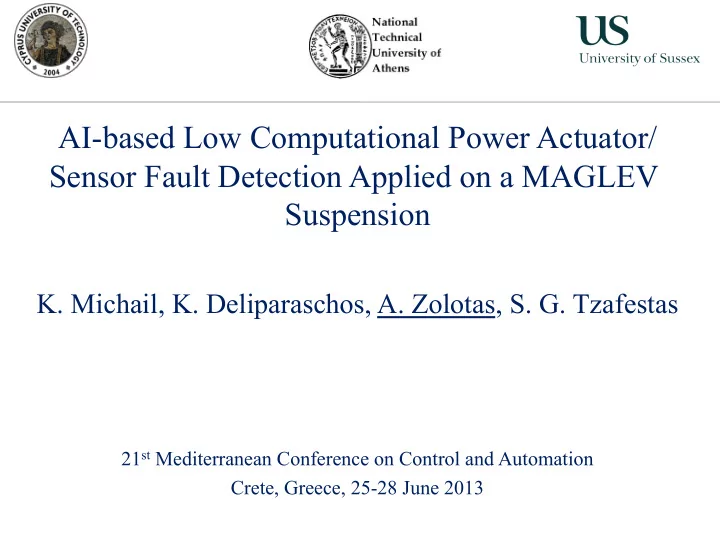

AI-based Low Computational Power Actuator/ Sensor Fault Detection Applied on a MAGLEV Suspension K. Michail, K. Deliparaschos, A. Zolotas, S. G. Tzafestas 21 st Mediterranean Conference on Control and Automation Crete, Greece, 25-28 June 2013
CONTENTS Ø Introduction Ø The proposed sensor fault detection scheme Ø Training the fault detection unit Ø The case study: A maglev suspension Ø Simulations Ø Conclusions MED ’ 13 Control Conference Crete, Greece
A Typical System Disturbances Uncertainties System Non-linearities Inherently Faults Faults Unstable propose FTC scheme for sensor fault detection MED ’ 13 Control Conference with low computational cost Crete, Greece
Sensor/actuator signals estimation Actuators (Driving Signals) Sensors iFD unit (Measurements) Typical bank of estimators (NN-based) for sensor FD MED ’ 13 Control Conference Crete, Greece
CONTENTS Ø Introduction Ø The proposed sensor fault detection scheme Ø Training the fault detection unit Ø The case stud: A maglev suspension Ø Simulations Ø Conclusions MED ’ 13 Control Conference Crete, Greece
Proposed Fault Tolerant Scheme BS MED ’ 13 Control Conference Crete, Greece
CONTENTS Ø Introduction Ø The proposed sensor fault detection scheme Ø Training the fault detection unit Ø The case study: A maglev suspension Ø Simulations Ø Conclusions MED ’ 13 Control Conference Crete, Greece
Neural Network: Training data set of the iFD Sensors Measured signals Estimated signals MED ’ 13 Control Conference Crete, Greece
Neural Network architecture Driving Signal Input Hidden Output Layers Layers Layers MED ’ 13 Control Conference Crete, Greece
CONTENTS Ø Introduction Ø The proposed sensor fault detection scheme Ø Training the fault detection unit Ø The case study: A maglev suspension Ø Simulations Ø Conclusions MED ’ 13 Control Conference Crete, Greece
The test case: Maglev System Controller K Track Flux circulation Pole Airgap Electromagnet Signal Driving Current F Vert. Accleration Power Amplifier Vert. Velocity Mg EMS serves two purposes: Suspended mass (m) Ø Support the vehicle and passengers MED ’ 13 Control Conference Ø Ensure proper ride quality Crete, Greece
Input disturbances and performance requirements Stochastic Deterministic Aim: Maintain the Control performance within limits under deterministic and stochastic disturbances while ensuring Performance requirements the control performance in the presence of sensor faults. MED ’ 13 Control Conference Crete, Greece
A FTC scheme for sensor fault detection of the EMS EMS Sensor Fault Accommodation Recovery 1. Single or Multiple Sensor Occurs 2. Fault is Detected 3. Faulty sensor/s Isolation 4. Controller Reconfiguration MED ’ 13 Control Conference Crete, Greece
Sensor Fault Modelling x5 Additive Multiplicative MED ’ 13 Control Conference Crete, Greece
Sensor Fault Scenaria Ø Abrupt faults; additive faults the normal sensor ’ s output value superimposed with a low frequency random signal and multiplicative faults result to sensors ’ output 5 times larger than normal. Ø 4 sensors in the maglev sensor set; assuming only 3 can fail i.e current i, vertical velocity and the vertical acceleration. Ø Both the abrupt/multiplicative and abrupt/additive sensor fault profiles are used for each sensor, Ø Subsequent faults can happen with a time difference of about 1 second. MED ’ 13 Control Conference Crete, Greece
CONTENTS Ø Introduction Ø The proposed sensor fault detection scheme Ø Training the fault detection unit Ø The case study: A maglev suspension Ø Simulations Ø Conclusions MED ’ 13 Control Conference Crete, Greece
Simulation results Mu. – Multiplicative faults St. – Stochastic response Ad. – Additive faults Dt. – Deterministic response FA – False alarms MED ’ 13 Control Conference Crete, Greece
Sensor Fault Sequence Fault free Accel. Fault vel. Fault vel. Fault MED ’ 13 Control Conference Crete, Greece
Binary Switch state BS Output change Switching point From Decision making unit MED ’ 13 Control Conference BS Crete, Greece
A comparison A bank of Kalman estimators have been compared with the iFD unit. The results show that the iFD unit is about 10 times faster than the bank of Kalman filters. Kalman Filters iFD MED ’ 13 Control Conference Crete, Greece
CONTENTS Ø Introduction Ø The proposed sensor fault detection scheme Ø Training the fault detection unit Ø The case study: A maglev suspension Ø Simulations Ø Conclusions MED ’ 13 Control Conference Crete, Greece
Conclusions & Discussion Ø A fault detection mechanism is proposed aimed to minimise the computational cost. Ø The proposed iFD is applied to a MAGLEV system example. Ø The simulation results show promising results. Ø Potential in FPGA implementation MED ’ 13 Control Conference Crete, Greece
AI-based Low Computational Power Actuator/ Sensor Fault Detection Applied on a MAGLEV Suspension K. Michail, K. Deliparaschos, A. Zolotas, S. G. Tzafestas A. Zolotas acknowledges Univ of Sussex for travel grant support MED ’ 13 Control Conference Crete, Greece
Recommend
More recommend